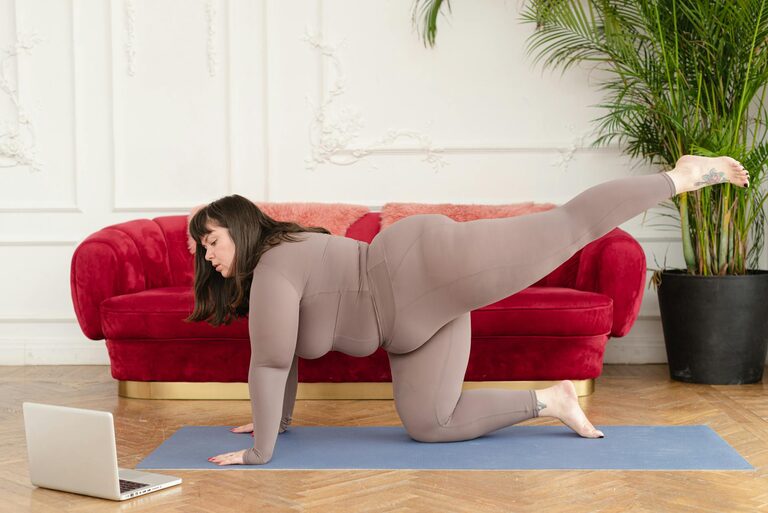Stretching is a simple and effective way to improve your physical health, enhance flexibility, and reduce muscle tension. Whether you’re new to exercise or looking for ways to relax at home, incorporating stretching into your daily routine can offer numerous benefits. This beginner’s guide will walk you through the basics of stretching at home, including the types of stretches, tips for safe practice, and a simple routine to get started.
Why Stretching Matters
Stretching helps increase the range of motion in your joints and muscles, which can improve your overall mobility. It also encourages better posture, enhances circulation, and reduces the risk of injury during physical activity. For those leading a mostly sedentary lifestyle, regular stretching can combat stiffness and improve comfort.
Types of Stretching
Before jumping into your stretching routine, it’s helpful to understand the two main types of stretches:
1. Static Stretching
Static stretches involve holding a stretch in a comfortable position for a period, typically between 15 and 60 seconds. This is great for relaxing muscles after exercise or as a gentle way to improve flexibility over time.
2. Dynamic Stretching
Dynamic stretches involve moving parts of your body through a full range of motion in a controlled manner. These stretches are often used as a warm-up before workouts to activate muscles and prepare your body for activity.
Getting Started: General Tips for Stretching at Home
– Warm up first: Stretching cold muscles can lead to injury. Before you stretch, spend 5 to 10 minutes warming up with light activity like walking or marching in place.
– Focus on major muscle groups: Target muscles like your hamstrings, calves, quadriceps, back, shoulders, and neck.
– Breathe steadily: Maintain smooth and steady breathing during each stretch to help your muscles relax.
– Don’t bounce: Avoid bouncing or jerky movements while stretching; hold each stretch steadily instead.
– Listen to your body: Stretching should create a feeling of gentle tension, not pain. Ease off if you feel any sharp or intense discomfort.
– Be consistent: Stretching regularly—ideally daily—will provide the best results over time.
A Simple Stretching Routine for Beginners
Try the following sequence of stretches at home. Spend about 20-30 seconds on each stretch and repeat 1-2 times.
Neck Stretch
– Sit or stand up straight.
– Slowly tilt your head to the right, bringing your ear toward your shoulder.
– Hold the stretch, then switch sides.
Shoulder Roll
– Stand or sit comfortably.
– Roll your shoulders forward in a circular motion 10 times.
– Reverse direction, rolling your shoulders backward 10 times.
Chest Stretch
– Stand near a doorway.
– Place your forearms on the door frame with elbows at shoulder height.
– Step forward gently until you feel a stretch in your chest muscles.
Seated Hamstring Stretch
– Sit on the floor with one leg extended straight.
– Bend the other knee so your foot touches the inner thigh of the extended leg.
– Reach toward your toes on the extended leg without rounding your back.
– Switch legs.
Cat-Cow Stretch (Spine Mobility)
– Get on your hands and knees.
– Arch your back upward toward the ceiling (cat pose).
– Then slowly drop your belly down, lifting your head and tailbone (cow pose).
– Repeat several times.
Calf Stretch
– Stand facing a wall.
– Place your hands on the wall for support.
– Step one foot back and press the heel firmly into the floor.
– Keep your back leg straight and bend the front knee slightly.
– Switch legs.
Child’s Pose
– Kneel on the floor and sit back on your heels.
– Stretch your arms forward on the floor and lower your chest toward the ground.
– Hold and breathe deeply.
Incorporating Stretching Into Your Daily Life
Here are some easy ways to make stretching a regular habit:
– Stretch for a few minutes each morning to start your day refreshed.
– Take short stretching breaks during work to relieve tension.
– Stretch after physical activities like walking, cycling, or housework.
– Use stretching as a relaxing wind-down before bedtime.
Final Thoughts
Stretching at home is accessible, low-impact, and beneficial for nearly everyone. Starting slowly and staying consistent can help you gain flexibility, reduce muscle tightness, and improve overall comfort. Always remember to listen to your body and enjoy the process of connecting with yourself through mindful movement.
Try this guide’s routine today, and experience the positive effects stretching can bring to your daily life!

